The Impact on Football With and Without Fans
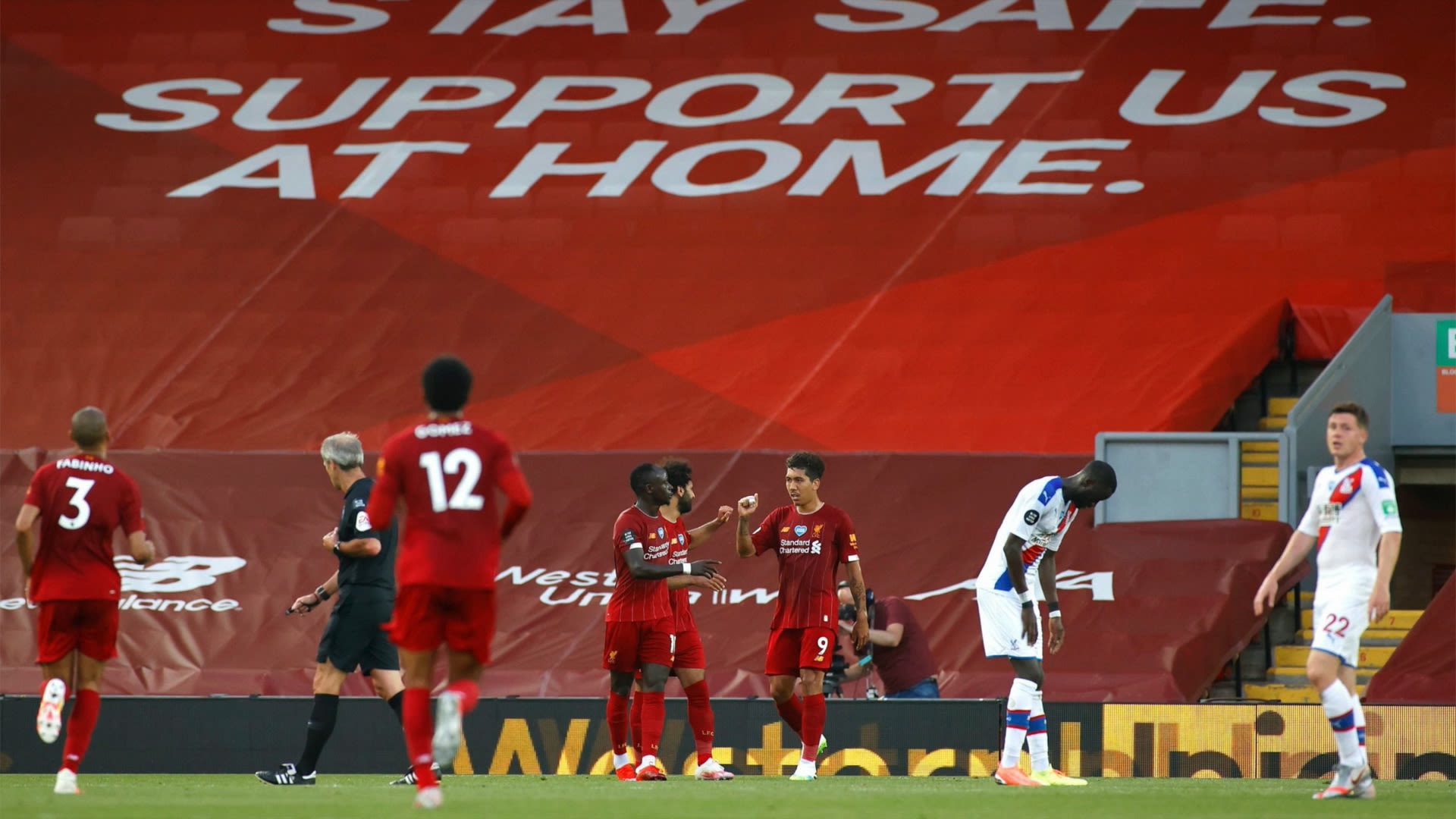
Coronavirus has had a detrimental impact on the entire world. It made the world stop. People’s livelihoods were stripped as they were ordered to stay at home to stop the spread and save lives. As a result of the pandemic, sport all around the world had to pause for a considerable amount of time, especially the Premier League, having its final fixture on the 9th of March and not returning until the 17th of June. This was the start of something new, no fans in stadiums.
In England, the Premier League went from having sell-out crowds in the 18/19 season to zero fans at the end of the 19/20 season and the majority of the 20/21 season. As many football fans know, football is not the spectacle it is without fans, but the question is, what impact do they actually have on the game when they are in attendance compared to when they are not? This will be uncovered throughout this piece, discussing topics such as how the game has changed since the pandemic, and whether there is such thing as a home advantage with or without fans.
This research will gather statistics and opinions from professional footballers and commentators who have been able to experience the football world adapting to coronavirus due to being some of the only people granted permission to attend live games during this time. Having this insight will provide much needed answers from first-hand experience to understand if football is impacted without fans.
Section 1.1:
Home Advantage

The term ‘Home Advantage’ has been used within football for decades, but what is it?
According to Science Direct, it is described as “the home team being more likely to perform better at their home ground as opposed to away from home”.
The home advantage seems to be clearest in stadiums such as Anfield and Old Trafford, which have been fortresses in recent years. This is due to their intimidating nature when at full capacity because of the atmosphere they create. The home advantage is mainly linked to the home team having the majority of their own fans in the stadium to support them, but as fans are not allowed in the stadiums at the moment, it is likely that the home advantage has decreased, therefore impacting the results of football games.
The 2018/19 Premier League season saw stadiums at full capacity week in, week out. During that season, there was only one team that had a better away record to home: Crystal Palace. Whereas a team like Liverpool did not lose one game at home all season. The 18 remaining teams also had a better home record, emphasising the importance of home crowds all across the board.
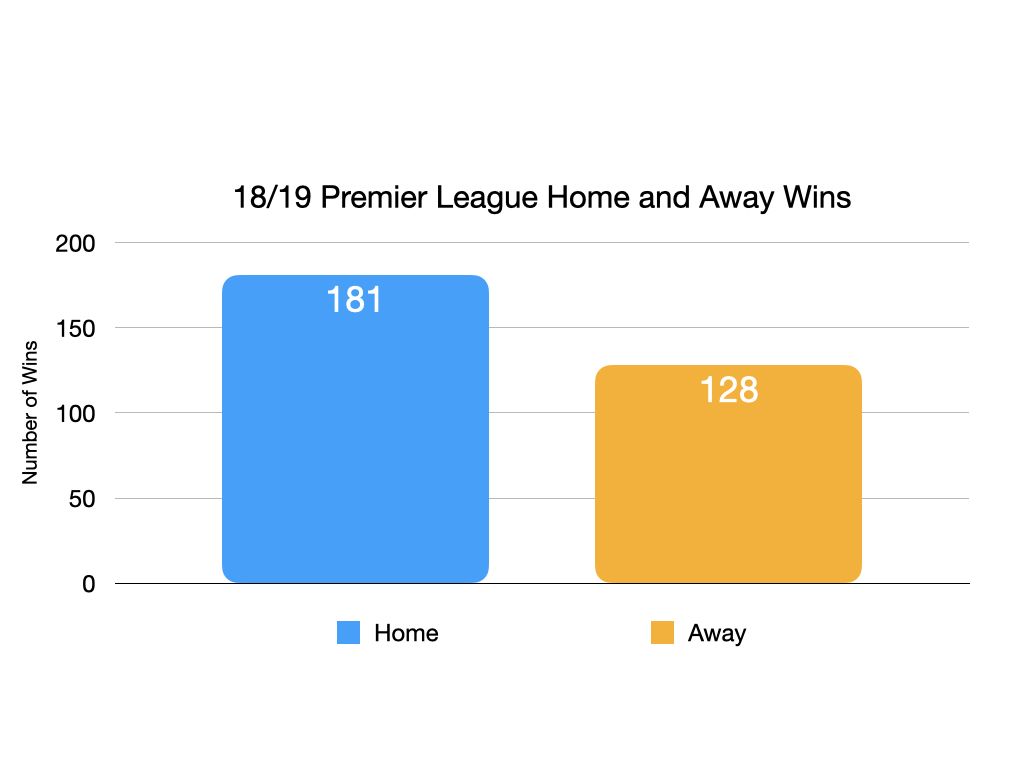
Data from Soccerstats.com
Data from Soccerstats.com
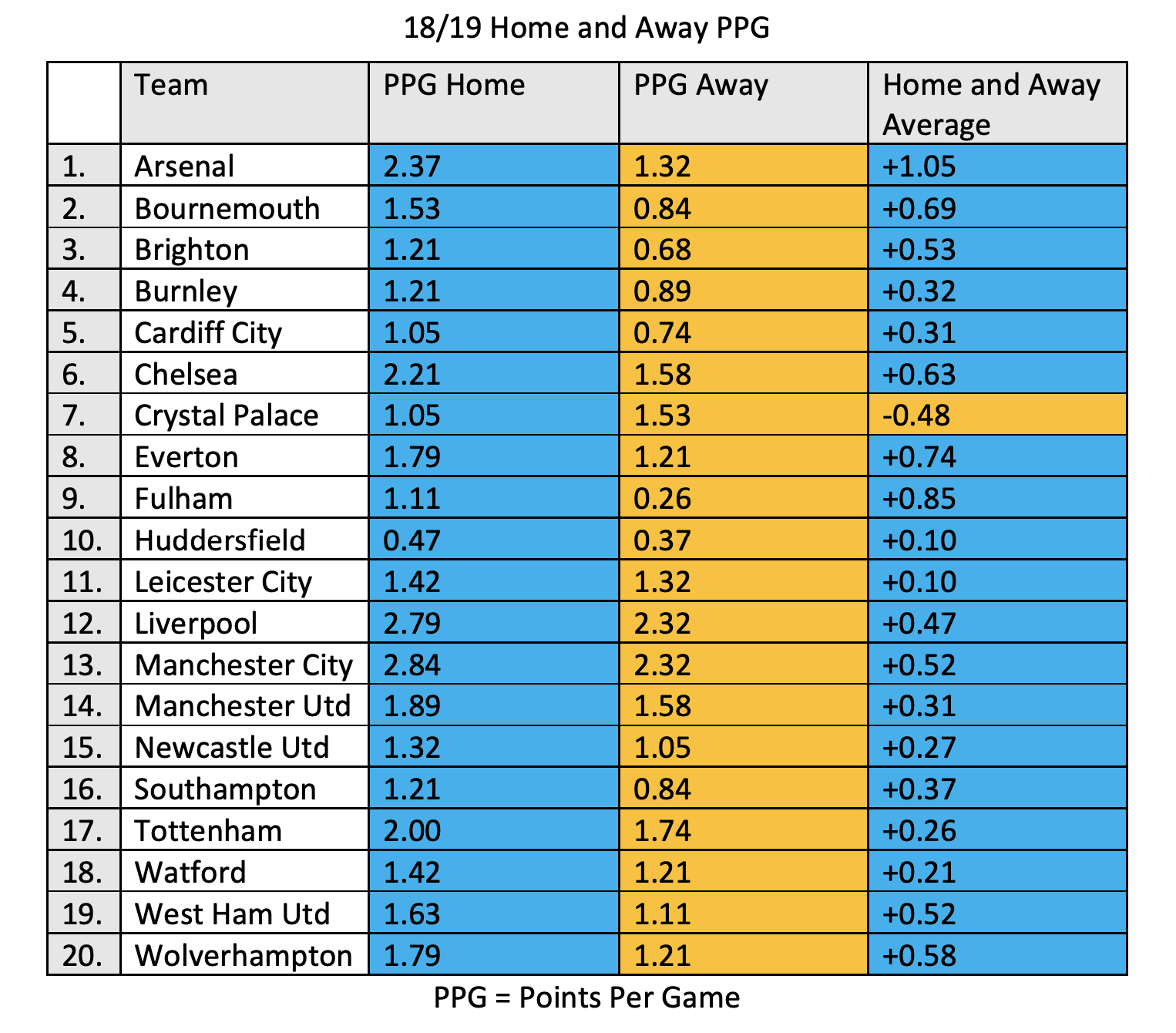
Data from Soccerstats.com
Data from Soccerstats.com
This form continued into the 19/20 season, where the first three-quarters saw more home wins than away wins.
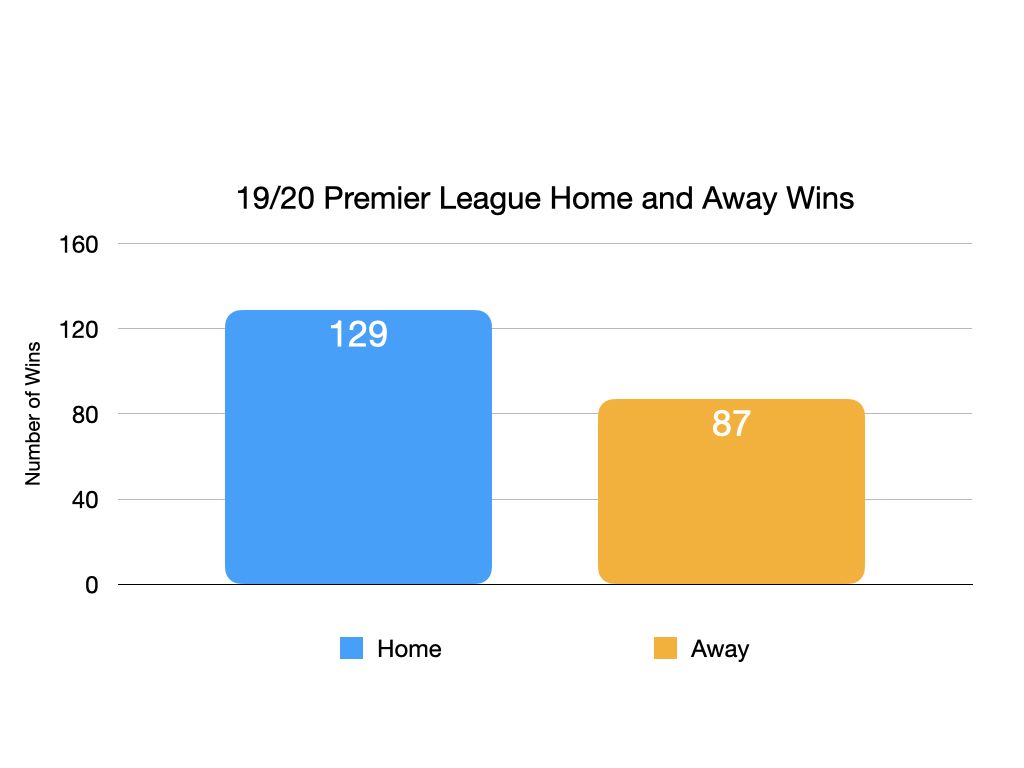
Data from Soccerstats.com
Data from Soccerstats.com
The final quarter of the league was hit by the pandemic, causing fans to not be able to attend games. As a result, there started to be a change in the outcome of games, this is something that the teams and players have probably not experienced much of in their careers.
“At first it was project restart which was the first time without fans. It was really strange and probably the first time in a near 15-year career where I have played in an empty stadium”
Dan Gosling - AFC Bournemouth and Watford

Despite the statistics still showing a greater number of home wins compared to away, the difference between the two was now only 14, perhaps suggesting that teams may have started to struggle without the support of fans and the different playing environment. Yet, once the season had finished, Southampton were the only team to have a better record away from home with a -0.52 Points Per Game (PPG) (minus sign indicating better away form).

Data from Soccerstats.com
Data from Soccerstats.com
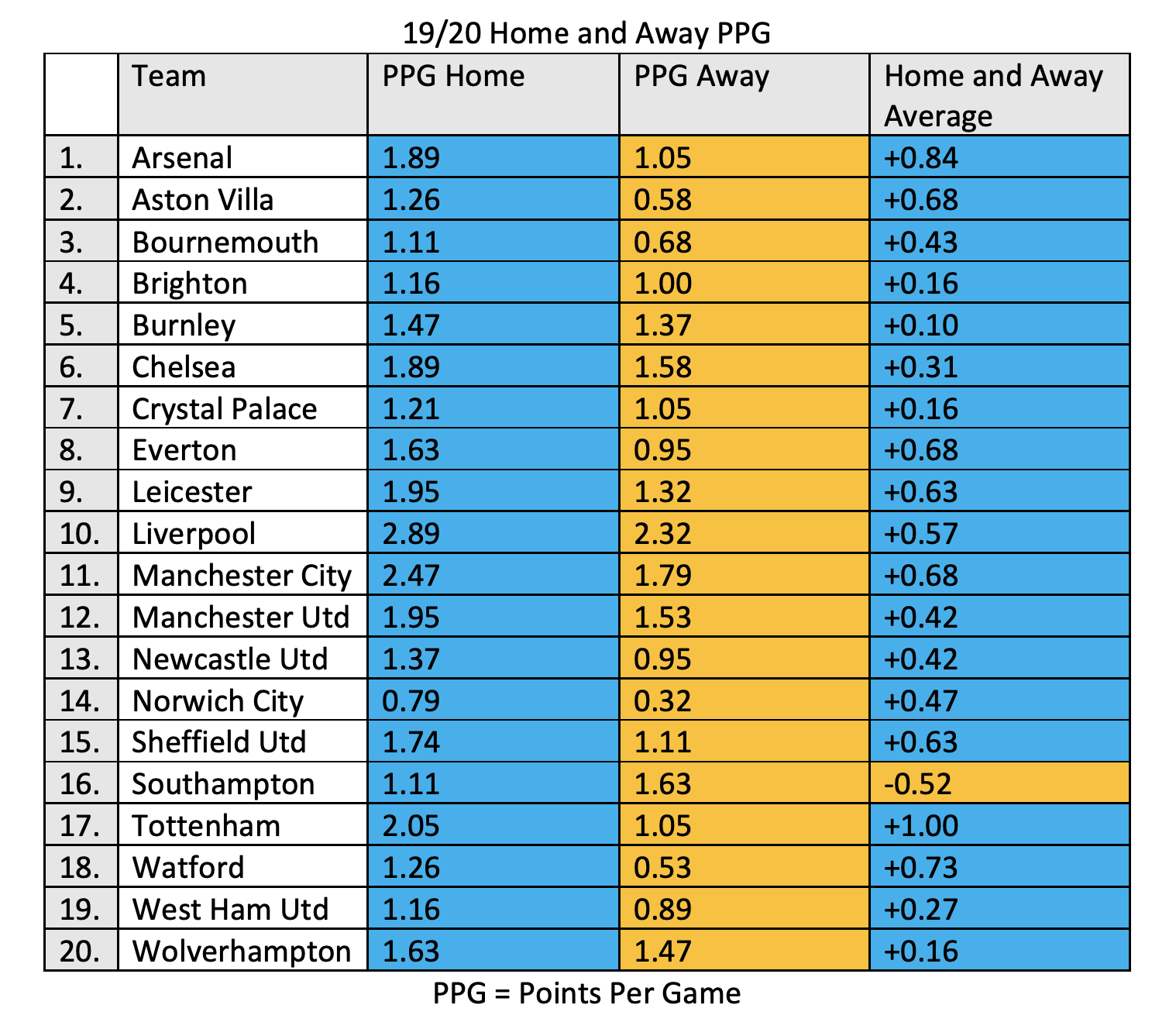
Data fromSoccerstats.com
Data fromSoccerstats.com
As shown in the PPG table, three of the ‘Big 6’s’ (Arsenal, Chelsea, Liverpool, Manchester City, Manchester United and Tottenham) home PPG decreased compared to the 18/19 season, which could signal that Arsenal, Chelsea and Manchester City seemingly suffered as a result of no fans, but not to the extent of some others in the league. Although three-quarters of the season had fans, the changes in results could show that teams who have bigger stadiums or rely more heavily on that home support could have been impacted more by the lack of fans.
The current 20/21 season saw the most drastic changes in team’s home and away records, with the home advantage scenario looking as though it had decreased considerably. 290 games were played up until the 21st of March and the away wins (39%) outweighed the home wins (37%), which, according to soccerstats.com, would break the previous highest away win percentage record in Premier League history (34% in the 18/19 season), if it continues. If the away win percentage is higher than the home percentage by the end of the season, this could show the impact that fans have at games, because even during the 18/19 season where there was a record number of away wins, there was still more home wins (48%) and therefore the home advantage still remained.
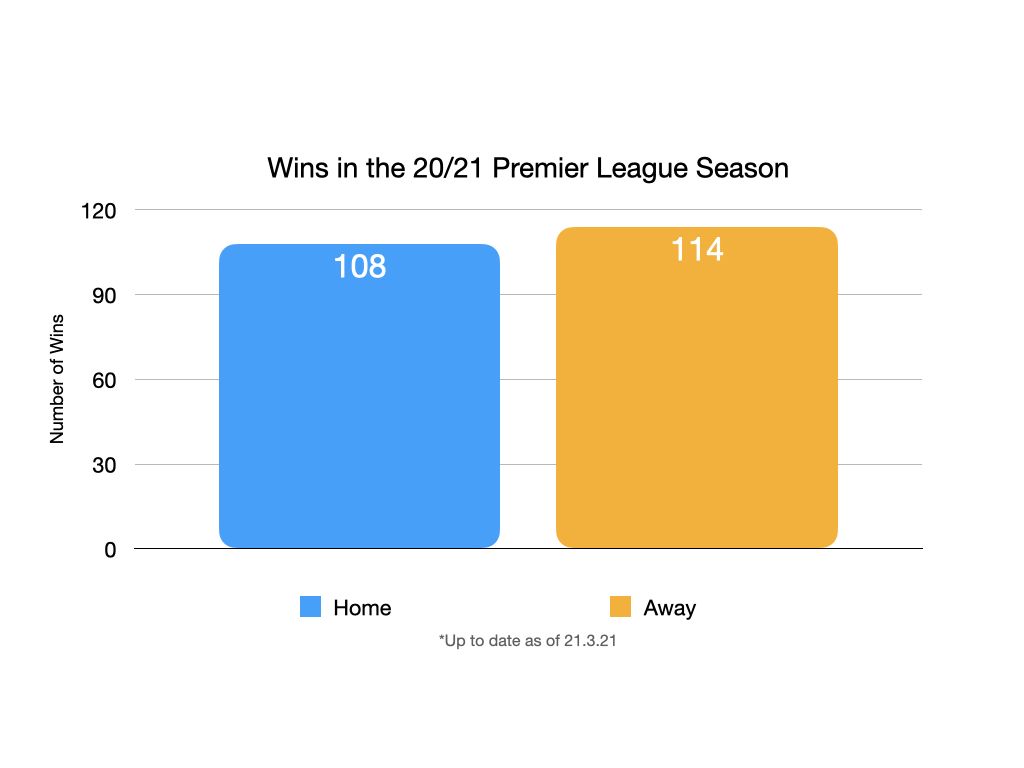
Data from Soccerstats.com
Data from Soccerstats.com

Data from Soccerstats.com
Data from Soccerstats.com
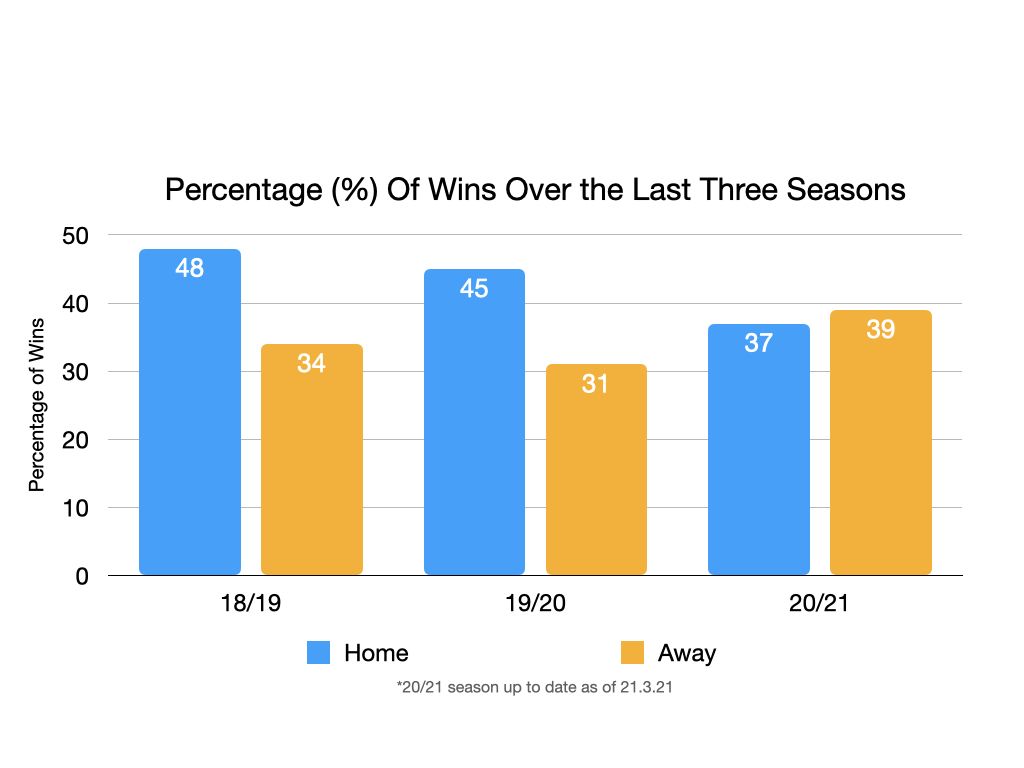
Data from Soccerstats.com
Data from Soccerstats.com
Out of the 20 Premier League teams, eight are performing better away from home, including lower positioned teams Brighton (16th) and Fulham (18th). Former England footballer and now presenter, Gary Lineker, shared his thoughts on the home advantage in February of 2021 when Brighton beat Liverpool 1-0 at Anfield:
“Fabulous win and performance from Brighton. That’s 5 games in the Premier League tonight with 5 away wins. Home advantage doesn’t exist without fans”
Gary Lineker - BBC

These statistics suggest that results started to change because fans were not in attendance, which could show the impact they have at matches. However, have players noticed a change in the home advantage since the stadiums have started to feel like neutral venues? Current Championship player Dan Gosling had this to say:
Having heard Gosling talk about how certain fan bases can push teams on to give them an advantage, particularly at home, this is what Sam Matterface and Clive Tyldesley had to say from a commentators’ point of view:
Getting views from professionals involved in the game has provided evidence that some teams have benefitted from having no fans and some teams have not. Teams like Manchester United, Everton and Leicester have been thriving away from home, potentially showing the benefit of travelling to empty stadiums where the home team no longer have the advantage of their fans. Although, a team like Manchester United having a better away record compared to home can be a serious indication that they are being impacted by not having their fans at Old Trafford. They have lost more games this season at home already compared to the previous two seasons, therefore, it may be that the stadium is not as intimidating without fans.

Data from Soccerstats.com
Data from Soccerstats.com
However, this is not always the case as some teams have stronger home records compared to away. Chelsea and Manchester City saw their home form dip at the end of last season but seem to have adapted this season by being stronger at home again. One standout team that have benefitted without fans at their home ground is West Ham. They are currently second in the home form table and fourth in the league, which is a substantial change in comparison to the previous two seasons, showing that no fans in stadiums impact certain teams in different ways.
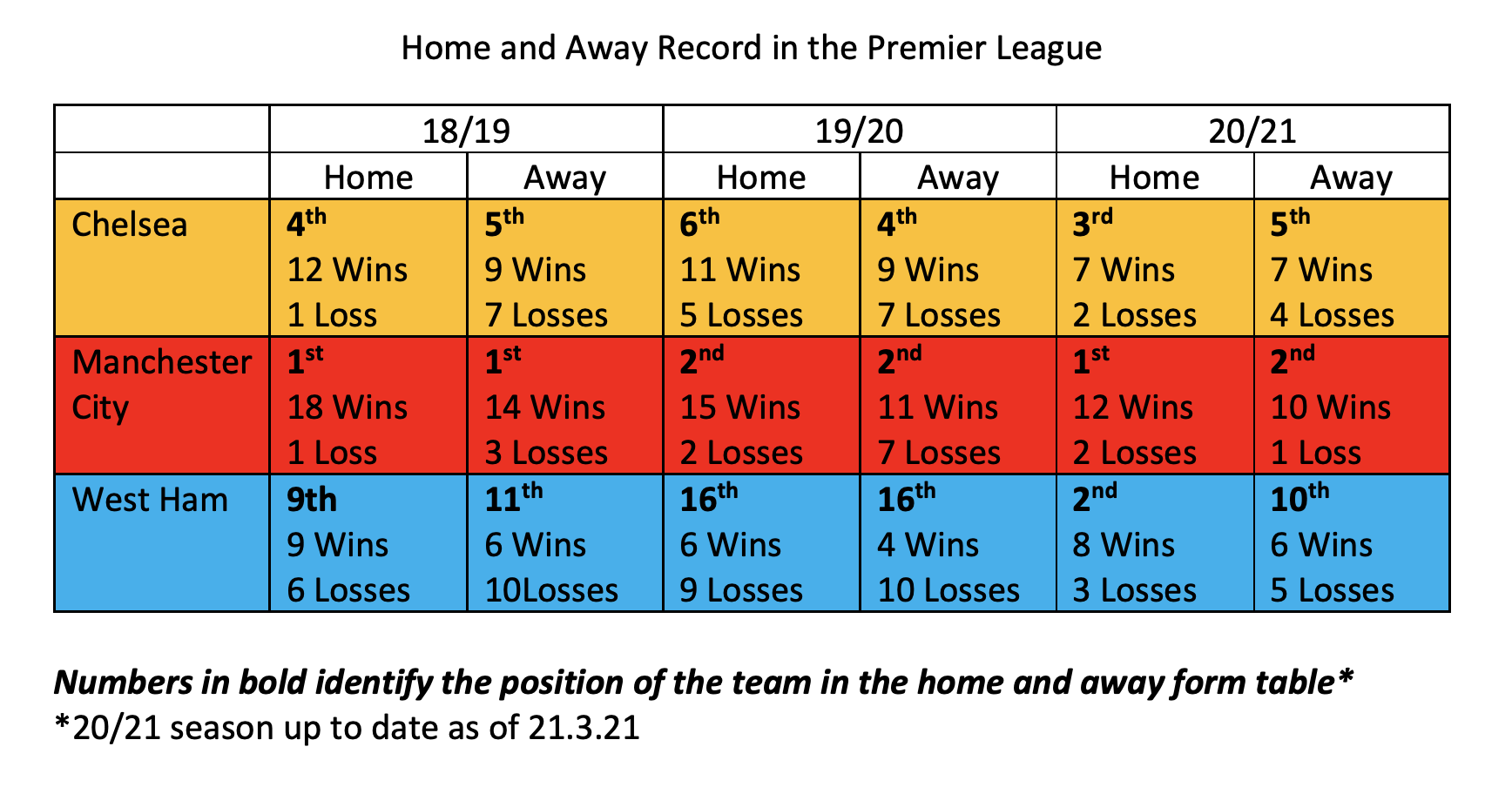
Data from Soccerstats.com
Data from Soccerstats.com
Finally on the home advantage, Liverpool’s form has been impacted all round without fans. Whilst they have had their fair share of injuries, the statistics show a clear drop in form in the 20/21 season.
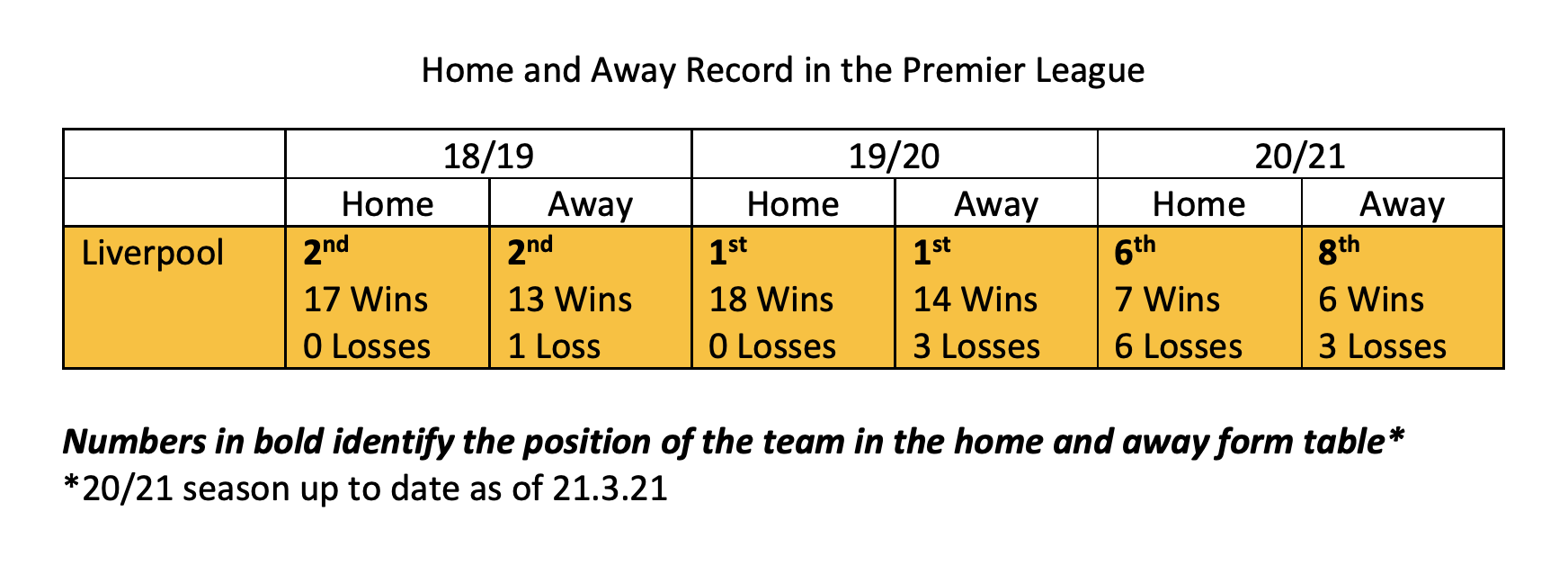
Data from Soccerstats.com
Data from Soccerstats.com
Section 1.2: Liverpool FC
In the 18/19 season and going forward into the 19/20 season, Liverpool had an unbeaten run of 44 games home and away and did not lose a Premier League game at home for 68 games. Throughout these two campaigns, Liverpool only lost one game up until project restart, when fans were told they were not allowed to attend games. They then went on to lose two games during that period but still won the Premier League title.
Three losses in two seasons was an exceptional record to take into a new season, and in the 20/21 season they started off positively with only one loss before January. However, the performances they were putting in were not Liverpool’s usual standard. They picked up a couple of injuries in defence but still had their main core squad on the field.
After January, Liverpool’s form changed, begging the question as to whether they started to be impacted by having no fans. On the 21st of January, Liverpool endured their first home loss in 68 games, when Burnley beat them 1-0. Although, the most significant moment to come at Anfield was their 2-0 loss to Merseyside rivals Everton. This game created history for both sides, negatively for the Reds but positively for the Toffees. As stated by the BBC, Everton’s last victory at Anfield was in 1999 and having Gylfi Sigurðsson scoring a penalty to seal their victory was also a momentous moment, with it only being Everton’s third penalty at Anfield since World War Two.
For Liverpool, this loss resulted in them picking up their fourth home loss on the bounce for the first time since 1923, this being one of Liverpool’s most painful defeats in their history. To add to their dreadful run, they then lost to two London clubs in Chelsea and Fulham, leading them to a new record of six consecutive home losses for the first time in the clubs 129-year history.
This is significant as it happened during a year when Champions Liverpool looked to be on the rise. Could the coronavirus causing fans to not be able to attend matches be the reason for their form dipping to this extent? Jürgen Klopp and Gini Wijnaldum expressed their thoughts on this.
It is clear that both the coach and the player understand how important fans are and how they create an atmosphere that helps the players on the pitch, something which they said they would have needed to try and change some of their recent results. According to Transfermarkt, over the last two seasons Liverpool averaged a staggering 47,469 fans at Anfield, excluding the virus hit 20/21. As these fans would have been majority Liverpool supporters, it is clear that they would have impacted the noise in the stadium and created an intimidating atmosphere for the travelling side. It is safe to say, they want their fans back.
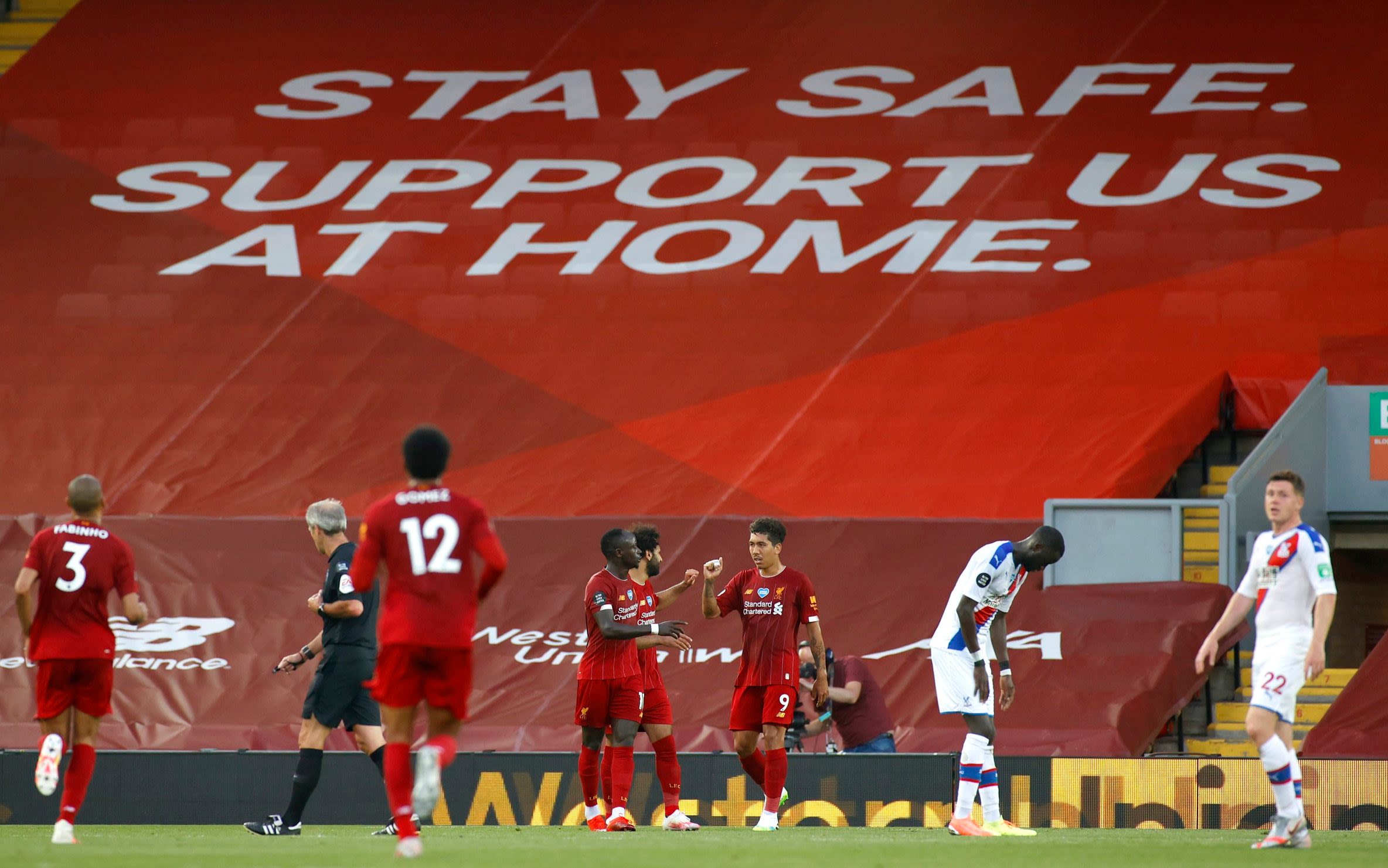

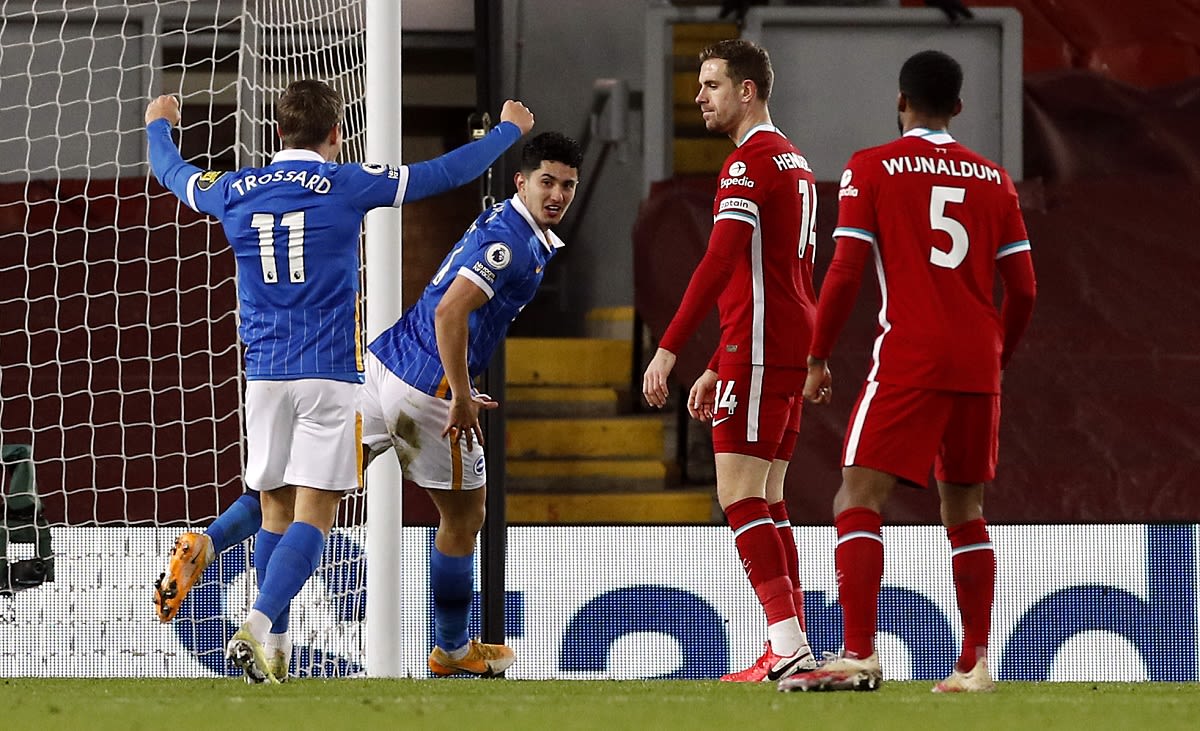
Section 2:
Atmosphere

Stadiums all around the world can be intimidating for away teams due to the atmosphere that the fans create at games. The pandemic has shown that the lack of fans can negatively impact a game for most sides, something that Jim Beglin picked up on:
“Badly missing proper atmospheres but really enjoying this season’s rollercoaster Premier League. 17 teams (most with strong identities) capable of beating one another on any given day and even an increasingly detached bottom three can offer coherent moments. Lots of quality” Jim Beglin - BT Sport
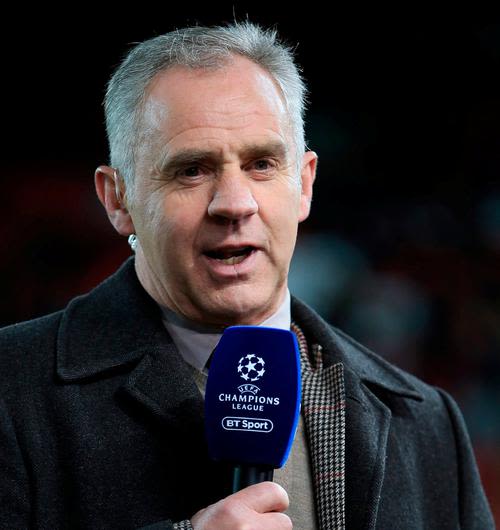

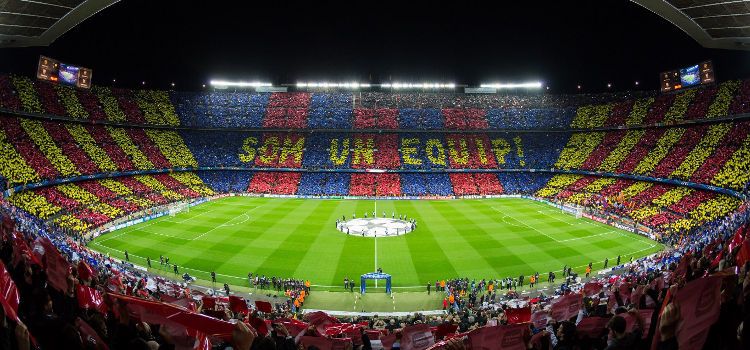
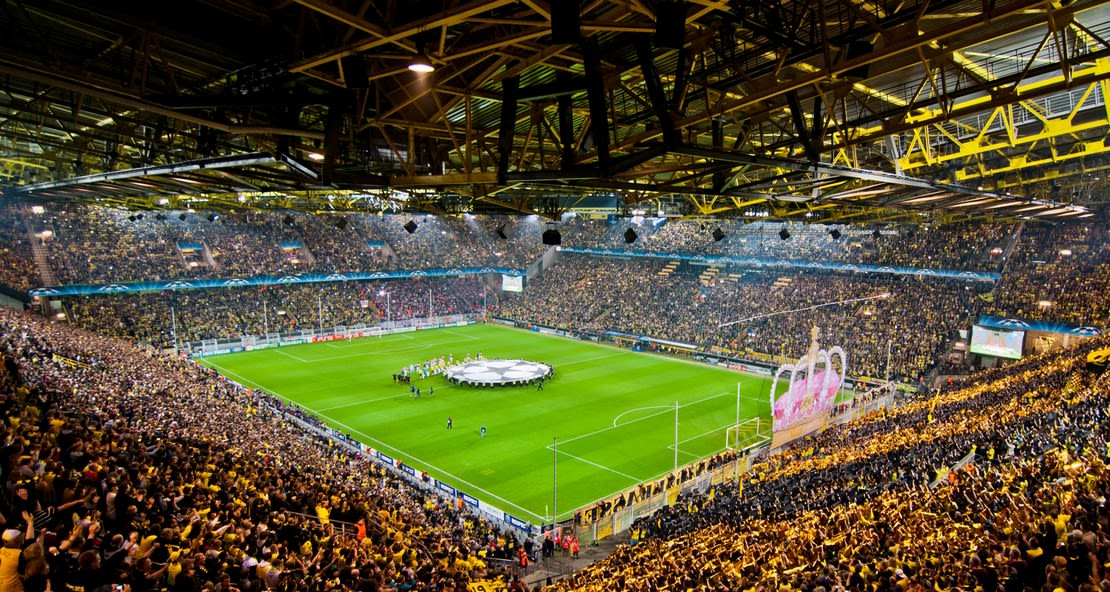
Focusing on the Premier League, some teams seem to be benefiting away from home as a result of the home side not having their fans in attendance, minimising the pressure on away teams. Because of this, over the last year, games without fans have been likened to neutral venues. Perhaps this could be a reason why results and performances have changed so considerably.
Teams like Fulham and Brighton appear to be profiting from this scenario after both sides picked up three points at Anfield respectively. Having teams at the lower end of the table picking up maximum points at a ground like Anfield displays the unpredictable nature of the Premier League without fans. This means that sides which rely on their home support to get victories could be impacted.
In the last two seasons Wolverhampton Wanderers finished 7th in the table, but this season are currently sitting in 14th. This could partly be due to fans not being in attendance at the Molineux to create the atmosphere they normally would, showing the impact it is having on most teams in the Premier League. Tyldesley suggests that it is even affecting top teams like Manchester City to some extent.
During December, there was a period of time that saw some clubs be allowed 2,000 fans in attendance as lockdown eased, with Everton being one of them. They played two games with fans and beat both Chelsea and Arsenal. This stood out due to their poor home form both before and after these games, something that TalkSport commentator Sam Matterface picked up on.
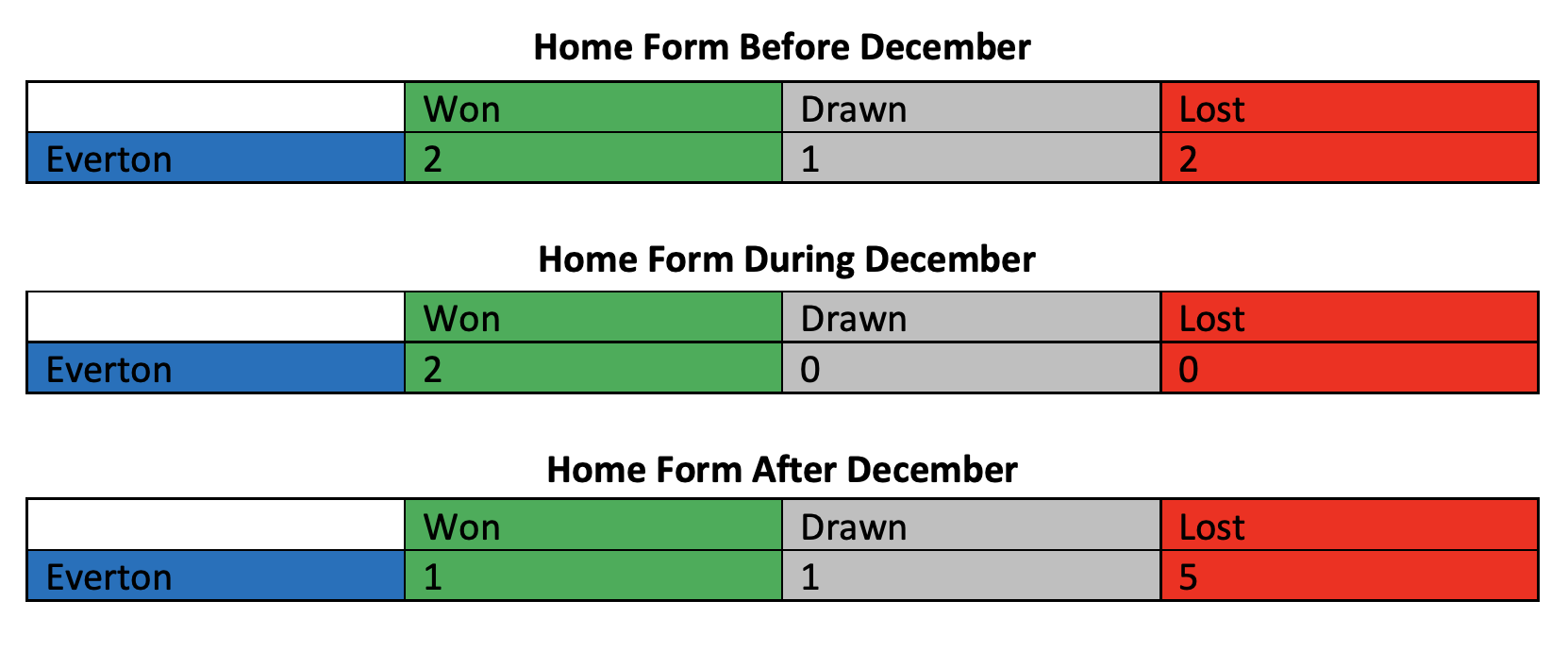
Data from Soccerstats.com
Data from Soccerstats.com
This can prove that Everton’s players perform better in front of a crowd. It is likely that the atmosphere spurs them on, leading the players to try and impress their supporters. Whereas without that, the game lacks intensity.
“The fans are such a huge, huge part of that [atmosphere]. I find that there are long spells where there is a lack of urgency and the coaches are a lot more vocal because they can sense it too [the lack of atmosphere in the stadium]”
Gary Taphouse - Sky Sports

This exposes the detrimental impact that no fans seem to be having on football. The change in atmosphere also seems to be taking away the possibility of a home advantage and may be affecting the way the game is played.
Section 3:
The Way the Game Is Played

Another factor that could be impacted by no fans being in attendance is the way the game is played. According to Gary Taphouse and Gary Sawyer, the tempo of the game has become a lot slower and the stadiums are quieter. This has been noticed particularly on TV as players and coaches are easily heard, something that is extremely rare in football.
There is however one positive from a home side’s perspective, they tend to have longer periods on the ball, gaining an upper hand on the possession percentages. Despite this, this has not benefited many teams this season in terms of winning matches. It is likely that if teams had that home support in the stadium with a higher possession percentage, it could have provided them with that boost to find a vital goal, something that Gosling implied previously in the home advantage audio clip.
This was evident this season in a period between the 2nd and the 4th of February as the home team had the higher possession in eight of the ten matches, but these games did not always result in wins for the home side.
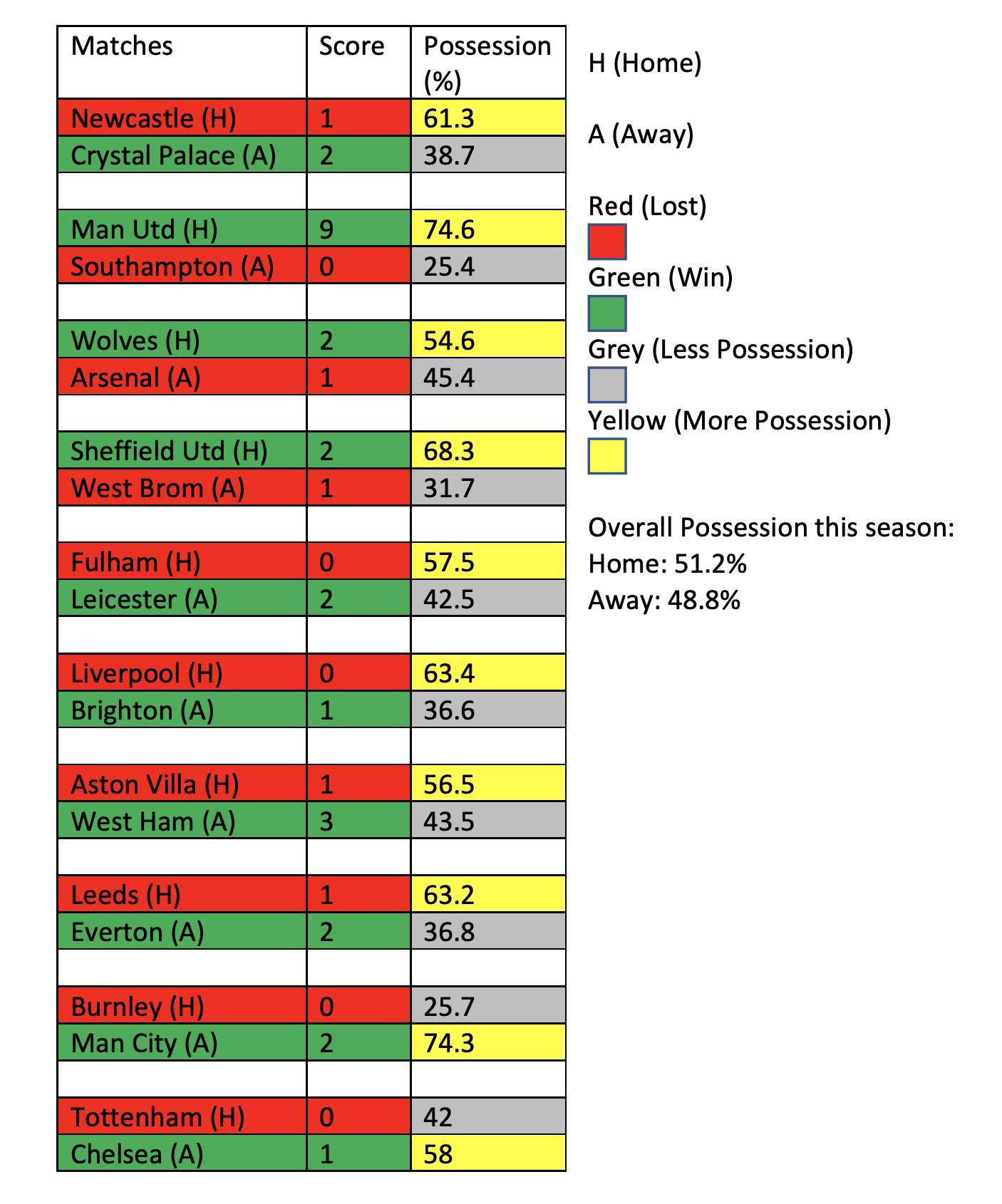
Data from Premierleague.com
Data from Premierleague.com
A consequence of the game being played at a slower pace is that it has resulted in there being fewer goals scored in the 20/21 season compared to the 18/19 and 19/20 seasons. After 290 games this season, there has been 759 goals compared to 787 goals (19/20 season) and 818 goals (18/19 season) being scored after the same number of games in these previous two seasons. It is also evident that goals are what many fans want to see in a game, and with there being less goals without them in attendance, this must prove at least to some extent the sort of impact they can have in a game. Taphouse explains how he has commentated on a lot fewer goals since the first lockdown:
There is noticeable evidence that the game has changed since the coronavirus took over the world of sport. It has seemingly impacted the home advantage, certain teams and the atmosphere in a negative way. But it is also worth considering whether the referees’ performances have been impacted too.
Section 4:
Referees' Performances

This 20/21 Premier League season has seen a change in the awarding of yellow and red cards, as well as penalties. There could be many factors at play, including those discussed already, with the main one being the ability of fans to impact a game. Over the last three years, Video Assistant Referee (VAR) has been in use to help the referee, but in some instances, it has made the game become more controversial and the referees have come under added scrutiny. Therefore, whilst VAR may have influenced the number of cards and penalties being given, it would be interesting to see if the fans not being in attendance also played any role. Tyldesley gives his views on how he believes fans could play a part in these decisions and discusses how VAR itself has put extra pressure on referees.
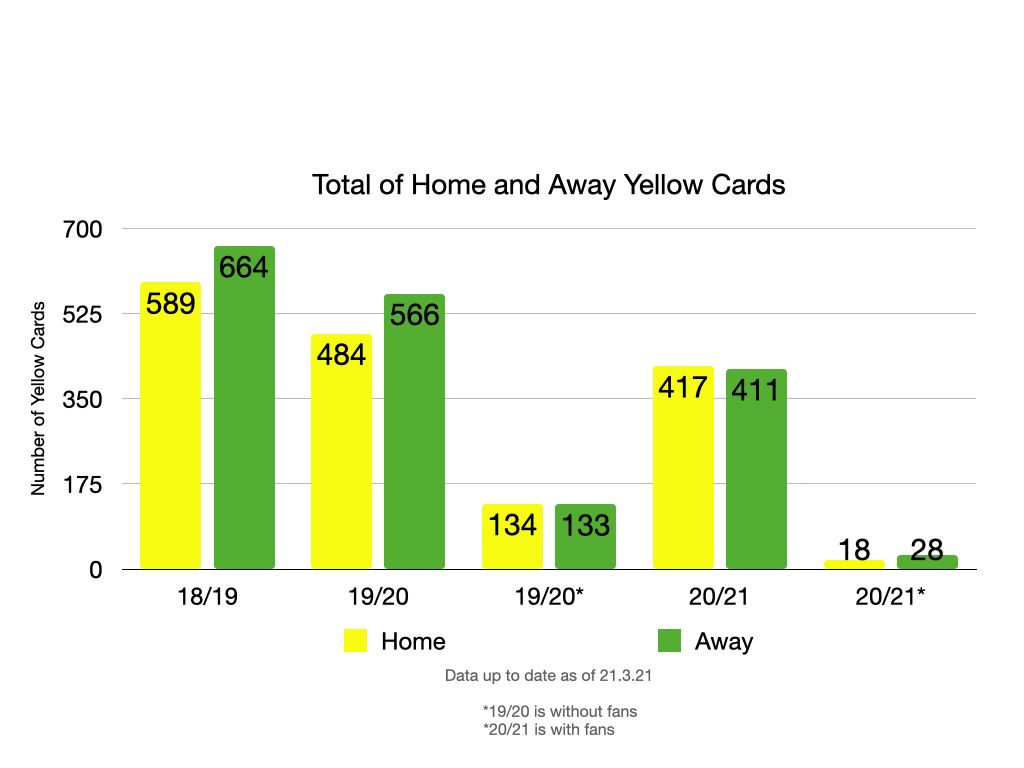
Data from Premierleague.com
Data from Premierleague.com
The statistics presented clearly show that the away teams picked up more yellow cards than the home teams in the 18/19 and 19/20 seasons (when fans were present). However, by the end of the 19/20 season and the majority of the 20/21 season, when fans were not present, the home teams collected more yellow cards than the away sides. This could show that without fans there to try and impact a referees’ decision, the balanced environment may alter how they officiate and could reduce the number of cards given overall. Matterface explains how he thinks decisions being made by the referee may be tighter now as a result of fans not being in attendance, but also does not think the rules in the game are helping the officials.
As VAR mainly focusses on penalty kicks and red cards, the statistics that surround them may not solely be due to how the referee officiates. However, there has been a change in the number of penalties awarded in the 20/21 season compared to the previous two seasons. After only 290 games, more penalties have been awarded to the away sides (48) compared to the home teams (46). Also, the 20/21 season has already seen two more penalties than in the whole of the 19/20 season and is only nine penalties away from matching the 103 penalties given in the 18/19 season. Despite this, there was a more equal balance in how many red cards were awarded in the 19/20 season, with 17 for the home sides and 18 for the away sides. This balance is also evident in the games played without fans, with both sides being awarded five each.
These statistics could be a reflection of the referees adapting to their new circumstances of officiating without fans. The more equal home and away totals could be a consequence of the fans not being in attendance, specifically in regard to yellow cards. Certain decisions may have been impacted due to there being no pressure on the referee from supporters.
During a trial period this season when limited fans were allowed to attend matches, Gosling noticed that because the home team had their own supporters there, the referee was influenced, and decisions often went against Goslings’ team.
Final Score:
Coronavirus 1-0 Football

All of the factors discussed in this research have clearly been impacted as a result of fans not being in attendance at football games since the coronavirus pandemic hit the United Kingdom. The main impact of which seems to be the decline in the home advantage, likely due to the home team fans not being there in their tens of thousands.
However, it is not just the home advantage that the fans seem to impact, it is clear that the atmosphere is not the same, the way the game is played is different and the referees’ decisions have also been affected. It has seen big teams like Liverpool have a decline in their form and so-called smaller teams in the Premier League benefit. This could be due to the amount of pressure on them reducing, and the neutral venue scenario making it feel like more of a level playing field for the majority of teams.
Despite no fans being in attendance, a few games have still brought excitement, like Liverpool losing 7-2 to Aston Villa and Leicester City beating Manchester City 5-2. Although, this has not been a regular occurrence, with the majority of games lacking their usual intensity. Therefore, this shows that football is simply not the same without the fans and the quicker they can return, the better the game will be.
